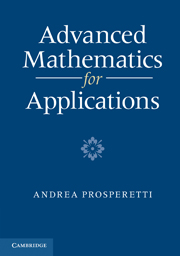2 - Some Simple Preliminaries
Published online by Cambridge University Press: 05 June 2012
Summary
This chapter collects in a simplified form some ideas and techniques extensively used in Part I of the book. This material will be revisited in greater detail in later chapters, but the brief summary given here may be helpful to readers who do not have the time or the inclination to tackle the more extensive treatments.
§2.1 continues the considerations of the final section of the previous chapter and further explains the fundamental idea underlying the method of eigenfunction expansions. While this method may be seen as an extension of the elementary “separation of variables” procedure (cf. §3.10), the geometric view advocated here provides a powerful aid to intuition and should greatly facilitate an understanding of “what is really going on” in most of the applications of Part I; the basis of the method is given in some detail in Chapters 19 and 21 of Part III.
§2.2 is a reminder of a useful method to solve linear non-homogeneous ordinary differential equations. Here the solution to some equations that frequently arise in the applications of Part I is derived. A more general way in which this technique may be understood is through its connection with Green's functions. This powerful idea is explained in very simple terms in §2.4 and, in greater detail, in Chapters 15 and 16.
Green's functions make use of the notion of the so-called “δ-function,” the principal properties of which are summarized in §2.3. A proper theory for this and other generalized functions is presented in Chapter 20.
Information
- Type
- Chapter
- Information
- Advanced Mathematics for Applications , pp. 27 - 50Publisher: Cambridge University PressPrint publication year: 2011
